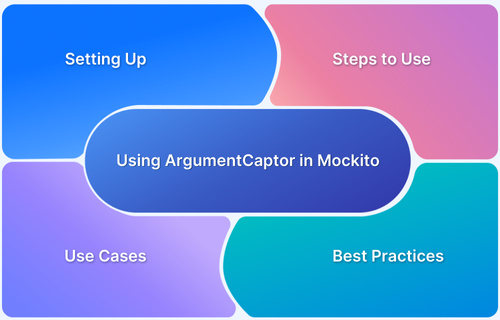Mockito is a widely used Java testing framework that enables efficient unit testing by mocking dependencies. One of its powerful features, ArgumentCaptor, enhances test verification by capturing method arguments passed to mocks.
Overview
ArgumentCaptor in Mockito allows capturing method arguments passed to mock objects, enabling precise validation in unit tests.
How to Use ArgumentCaptor:
Follow the steps below to use an ArgumetCaptor:
- Step 1: Set Up Dependencies and Mocks
- Step 2: Create a Test Class and Mock Dependencies
- Step 3: Define the Test Scenario
- Step 4: Capture Multiple Arguments
- Step 5: Verify Arguments with Conditions
Use Cases for ArguementCaptor
Popular use cases include:
- Testing Callbacks: Capture callback arguments to verify execution and expected behavior.
- Validating Method Parameters: Ensure correct values are passed to mocked methods.
- Testing Void Methods: Capture arguments in methods that don’t return values.
- Comparing with ArgumentMatchers: Use for precise argument validation instead of generic matchers.
Best Practices to UseArguementCaptor
Some best practices include:
- Only Use When Absolutely Necessary
- Verify Method Invocation Before Capturing
- Capture Arguments for Void Methods
- Use getAllValues() when using multiple calls
- Keep Tests Readable and Maintainable
This guide explores how to leverage ArgumentCaptor effectively for more precise and reliable Java testing.
What is Mockito?
Mockito is a popular Java framework for unit testing. It allows developers to create and manage mock objects. It simplifies testing by mimicking real objects and controlling their behavior, making it easier to test components in isolation.
Mockito is very useful in checking for method calls, setting return values, and testing for exceptions by not actually creating the dependencies. It is widely used in test-driven development to ensure code functions correctly by testing units in isolation.
Read More: How to Mock Exceptions in Mockito?
What is ArgumentCaptor?
ArgumentCaptor is a Mockito class that captures arguments passed to the mocked objects of methods. It helps verify interactions by retrieving argument values, which is useful when you want to inspect or assert method parameters.
Instead of relying on return values, ArgumentCaptor lets you check whether a method was called with expected arguments.
It is used when the application deals with callbacks or event listeners or where the argument itself is generated dynamically during the test. Argument capturing allows you to verify business logic without altering the test object.
Methods of the ArgumentCaptor Class
ArgumentCaptor provides several methods to capture and retrieve arguments during unit testing. Some key methods include:
- forClass(Class<T> clazz) – Creates an ArgumentCaptor instance for a given class.
- capture() – Captures the argument passed to a mocked method.
- getValue() – Retrieves the most recent captured argument.
- getAllValues() – Returns a list of all captured arguments.
Example of ArgumentCaptor
Here’s an example of how to use ArgumentCaptor in a Mockito test:
import static org.mockito.Mockito.*; import static org.junit.jupiter.api.Assertions.*; import org.junit.jupiter.api.Test; import org.mockito.ArgumentCaptor; import java.util.List; class ArgumentCaptorExampleTest { @Test void testArgumentCaptor() { // Mock a List object List<String> mockList = mock(List.class); // Use the mock object mockList.add("Mockito"); // Capture the argument ArgumentCaptor<String> captor = ArgumentCaptor.forClass(String.class); verify(mockList).add(captor.capture()); // Assert the captured value assertEquals("Mockito", captor.getValue()); } }
This example verifies that the add method was called with “Mockito”, demonstrating how ArgumentCaptor retrieves and validates method arguments.
Prerequisites for Using ArgumentCaptor in Mockito
Before using Mockito and ArgumentCaptor, you need to configure your testing environment. This involves adding dependencies and initializing mocks properly.
Adding Mockito Dependency
If you’re using Maven, add the following dependency to your pom.xml:
<dependency> <groupId>org.mockito</groupId> <artifactId>mockito-core</artifactId> <version>5.0.0</version> <scope>test</scope> </dependency>
For Gradle, add this to your build.gradle:
dependencies { testImplementation 'org.mockito:mockito-core:5.0.0' }
If you are using JUnit 5, you may also need mockito-junit-jupiter:
<dependency> <groupId>org.mockito</groupId> <artifactId>mockito-junit-jupiter</artifactId> <version>5.0.0</version> <scope>test</scope> </dependency>
Initializing Mockito and ArgumentCaptor
Mockito allows mock initialization in multiple ways:
- Using @Mock and @InjectMocks with MockitoAnnotations.openMocks(this)
- Manually creating mocks with mock(Class<T>)
Example using annotations:
import static org.mockito.Mockito.*; import org.junit.jupiter.api.BeforeEach; import org.junit.jupiter.api.Test; import org.mockito.*; import java.util.List; class MockitoSetupTest { @Mock private List<String> mockList; @BeforeEach void setUp() { MockitoAnnotations.openMocks(this); // Initializes mocks } @Test void testWithMockito() { mockList.add("Test"); verify(mockList).add("Test"); } }
Example using manual mock creation:
import static org.mockito.Mockito.*; import org.junit.jupiter.api.Test; import org.mockito.ArgumentCaptor; import java.util.List; class ManualMockitoSetupTest { @Test void testManualMock() { List<String> mockList = mock(List.class); // Manually create a mock mockList.add("Mockito"); ArgumentCaptor<String> captor = ArgumentCaptor.forClass(String.class); verify(mockList).add(captor.capture()); System.out.println("Captured Argument: " + captor.getValue()); } }
These prerequisites ensure that Mockito and ArgumentCaptor are properly configured, enabling effective unit testing.
Read More: Top 15 Unit Testing Tools
Using ArgumentCaptor in Mockito for Java Testing: A Step-by-Step Guide
ArgumentCaptor helps capture and inspect method arguments in unit tests, making it a valuable tool for verifying interactions. Here are the steps on how to use ArgumentCaptor effectively in Mockito-based tests.
Step 1: Set Up Dependencies and Mocks
Ensure Mockito is added to your project, as shown in the previous section. Then, initialize the required mocks.
Step 2: Create a Test Class and Mock Dependencies
Consider you have a UserService that saves user data using a UserRepository. In this case, you can mock the repository and use ArgumentCaptor to verify the saved user details.
import static org.mockito.Mockito.*; import org.junit.jupiter.api.BeforeEach; import org.junit.jupiter.api.Test; import org.mockito.*; class UserServiceTest { @Mock private UserRepository userRepository; @InjectMocks private UserService userService; @BeforeEach void setUp() { MockitoAnnotations.openMocks(this); } }
Step 3: Define the Test Scenario
Consider that UserService.saveUser() calls userRepository.save(User user), and you want to capture the User object passed to save().
import static org.mockito.Mockito.*; import static org.junit.jupiter.api.Assertions.*; import org.junit.jupiter.api.Test; import org.mockito.ArgumentCaptor; class UserServiceTest { @Test void testSaveUser() { // Arrange UserService userService = new UserService(userRepository); User user = new User("John Doe", "john@example.com"); // Act userService.saveUser(user); // Capture the argument ArgumentCaptor<User> captor = ArgumentCaptor.forClass(User.class); verify(userRepository).save(captor.capture()); // Assert captured values User capturedUser = captor.getValue(); assertEquals("John Doe", capturedUser.getName()); assertEquals("john@example.com", capturedUser.getEmail()); } }
Step 4: Capture Multiple Arguments
If a method is called multiple times, use getAllValues() to capture and verify all arguments.
@Test void testSaveMultipleUsers() { // Arrange UserService userService = new UserService(userRepository); User user1 = new User("Alice", "alice@example.com"); User user2 = new User("Bob", "bob@example.com"); // Act userService.saveUser(user1); userService.saveUser(user2); // Capture multiple arguments ArgumentCaptor<User> captor = ArgumentCaptor.forClass(User.class); verify(userRepository, times(2)).save(captor.capture()); // Assert captured values List<User> capturedUsers = captor.getAllValues(); assertEquals(2, capturedUsers.size()); assertEquals("Alice", capturedUsers.get(0).getName()); assertEquals("Bob", capturedUsers.get(1).getName()); }
Step 5: Verify Arguments with Conditions
Use ArgumentCaptor with assertions to check if an argument meets specific conditions.
@Test void testUserEmailValidation() { User user = new User("Charlie", "charlie@example.com"); userService.saveUser(user); ArgumentCaptor<User> captor = ArgumentCaptor.forClass(User.class); verify(userRepository).save(captor.capture()); assertTrue(captor.getValue().getEmail().contains("@")); }
Use Cases for ArgumentCaptor
ArgumentCaptor is a powerful feature in Mockito. It is useful in many testing scenarios where the exact parameters used in method calls are of interest.
Some of its use cases are:
- Testing Callbacks: Whenever a method takes callback parameters, it is possible to capture these callback arguments to ensure that they were invoked correctly. This guarantees the proper functioning of callback mechanisms.
- Validating Method Parameters: Methods are often invoked with complex objects or dynamically created data. Capturing such arguments using ArgumentCaptor will facilitate detailed inspection to ensure that methods get the right set of parameters while executing.
- Testing Void Methods: Traditional return-based verifications do not apply to methods with no returning value (void methods). ArgumentCaptor provides a means for capturing arguments passed to such void methods in order to make assertions about their behavior and ensure that they are indeed called with appropriate parameters.
- Comparing with ArgumentMatchers: Both ArgumentCaptor and ArgumentMatchers can be used to assert arguments. However, ArgumentCaptor is particularly beneficial when the argument’s value needs to be known for assertion rather than simple pattern or type matching.
ArgumentCaptor helps capture actual arguments passed to mocked methods and thus ensures that the right data passes through the system. However, ensuring the tests are accurate goes beyond unit testing.
Real-world testing happens over multiple environments, and developers can run tests on different devices and identify issues using a real device cloud, like BrowserStack, to ensure smooth functioning.
Best Practices for Using ArgumentCaptor
Use ArgumentCaptor properly in Mockito tests to ensure the validation of method arguments is done correctly. The following best practices increase test reliability and maintainability:
- Only Use When Absolutely Necessary: ArgumentCaptor is helpful in the case of strict parameter matching in method invocation, but not always. If just basic argument matching is good enough, prefer ArgumentMatchers, like general matchers, over explicit value capturing.
- Verify Method Invocation Before Capturing: Always ensure that the method was invoked before capturing arguments. This assures that ArgumentCaptor is used appropriately and avoids tests failing unexpectedly at assertion time.
- Capture Arguments for Void Methods: Void methods do not return values, but ArgumentCaptor can verify the data passed to them. The above ensures that the method actually works on the expected input.
- Use getAllValues() when using multiple calls: If a method is invoked multiple times, capturing all argument values helps verify if each call received the expected inputs. This is particularly useful when testing loops or iterative calls in the implementation.
- Avoid Capturing Primitive or Simple Types: General matches are more efficient than ArgumentCaptor for primitive values or simple data types. Capturing these values explicitly can add unnecessary complexity to tests.
- Keep Tests Readable and Maintainable: Overusing ArgumentCaptor can make tests harder to read. It should only be used when necessary, with clear assertions that improve test clarity and maintainability.
Read More: Understanding Assert in Java
Challenges and Limitations of ArgumentCaptor
ArgumentCaptor is a utility class that verifies arguments in Mockito. However, its usage has various challenges and disadvantages that developers ought to consider:
- Overuse Can Reduce Test Readability: Using ArgumentCaptor when it is not required can make tests cumbersome to read. For simple verification, ArgumentMatchers are usually far more concise and effective. Doing this for each argument manually increases complexity unnecessarily.
- Does Not Support Direct Capture of Primitive Arguments: ArgumentCaptor cannot be used for primitive data types such as int, double, or boolean. If a method accepts a primitive, then the developer needs to use wrapper classes like Integer or Double or resort to ArgumentMatchers instead.
- Doesn’t Support Static or Final Methods: Mockito does not directly support mocking static or final methods. ArgumentCaptor captures arguments from mock interactions so that it cannot be used with static method calls or final classes without extra tools like PowerMock.
- It Can Capture Unexpected Arguments in Overloaded Methods: If multiple overloads are in the same class, with different overloads having similar signatures, ArgumentCaptor may capture the arguments passed to an unwanted method. This will cause wrong assertions in case of wrong method invocation during testing.
- Needs Extra Asserts for Verification: An argument can be captured, but an assertion should also be included in the test to verify the captured value. This requires one extra step compared to the direct method of call verification using ArgumentMatchers.
- Inapplicable when one needs to test big collections: ArgumentCaptor may not be your best choice when a method deals with large lists or complex collections. Verifying individual elements becomes too cumbersome; sometimes, the custom matchers or collection-based assertions would even be more efficient.
Conclusion
Mockito offers different ways to verify method interactions, and ArgumentCaptor is a powerful tool when used correctly. It is best for capturing complex objects, multiple arguments, or verifying void methods.
However, developers should keep limitations in mind and not overcomplicate things. Real-world testing forms the basis of a well-designed test strategy.
Running automated tests on BrowserStack’s real device cloud ensures applications perform consistently across different devices, browsers, and network conditions.





